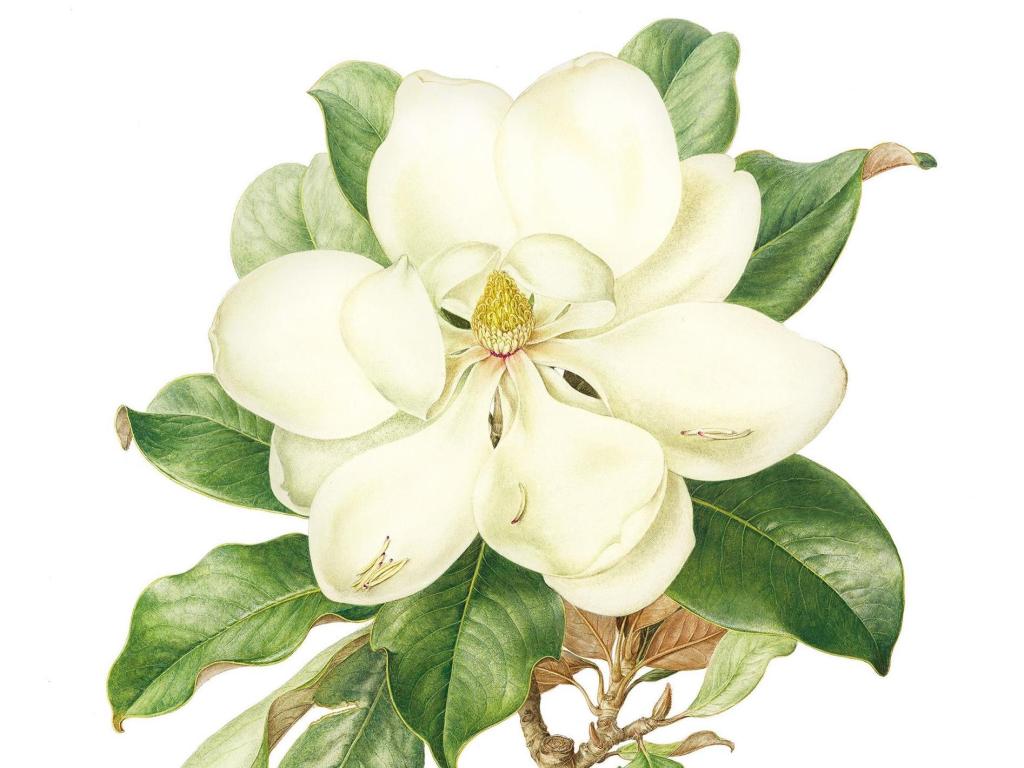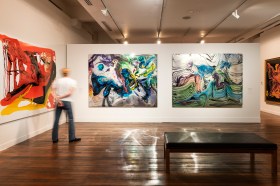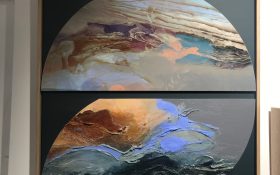Detail Magnolia grandiflora (Bull Bay Magnolia), Jenny Phillips. Image © Royal Botanic Garden, Sydney.
From the time Sir Joseph Banks landed at Botany Bay in 1776, botanical art has been a persistent feature of the Australian artistic landscape.
While many genres now eschew realism, ceding the territory of capture to photography and video, botanical artists continue to devote hundreds of hours to the detailed capture of a single plant.
In fact there has been a resurgence of botanical art in the past 20 years. What powers that enthusiasm is something of a mystery. Home gardening programs on television? Awareness of the environment in the face of climate change?
Colleen Morris believes the answer is much simpler. People just love nature and are drawn to the experience of sitting with and depicting the extraordinary detail and beauty of flowers.
Morris is Guest Curator of a new exhibition at the Museum of Sydney that takes a look the long history of botanical illustration in Australia from the early 19th century to now.
Florilegium: Sydney’s Painted Garden has been ten years in the making, and corrals together the collection of the Royal Botanic Garden’s Florilegium Society to celebrate the Garden’s 200th birthday.
87 documented species are on view in works created by 64 artists, both Australian and international. All have been gifted to the Garden’s Trust as the Florilegium at the Royal Botanic Gardens Sydney collection of botanical art.
Florilegium Sydney’s Painted Garden is the first time this unique collection has been presented to the public.
It is complemented by The Artist & the Botanical Collector: the Lost Works of Lovegrove & Baüerlen, which explores the partnership between an “amateur lady painter” from Shoalhaven and colonial botanical collector and their plot to produce a compendium of Australian wild flowers.
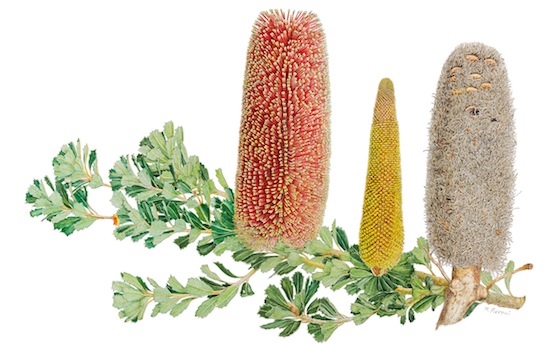
Banksia praemorsa (Cut-leaf Banksia), Margaret Pieroni. Image © Royal Botanic Garden, Sydney.
What’s a Florilegium?
Taken from the Latin work flos (flower) and legere (to gather), a florilegium is literally an anthology of flowers. Botanical illustration began in the 15th Century with the recording of herbs for medicinal texts but the florilegium extends the art form to ornamental plants.
They have flourished since the 17th century, recording the collections of specific gardens or, more recently, endangered plants.
The Sydney Florilegium Society was formed in 2005, to create a collection of contemporary botanical paintings of some of the most significant plants in the living collections of the Royal Botanic Gardens and Domain Trust.
The “Archibald” for garden lovers
This is much more than just a story about flowers, or shall we say decorative wall art.
Just as Australia’s famous portrait prize drives thousands of ordinary people into a gallery to see faces differently, botanical art has the potential to get audiences to look at the flowers around them with fresh eyes.
‘It is portraiture of a different kind and marvels audiences by the exceptional skill on display,’ said Morris.
‘To think that the hand of someone has painted these just blows you away because they look so perfect, you don’t see a brush stroke,’ she added.
All the works on display are watercolours, some of which take more than 200 hours to produce.
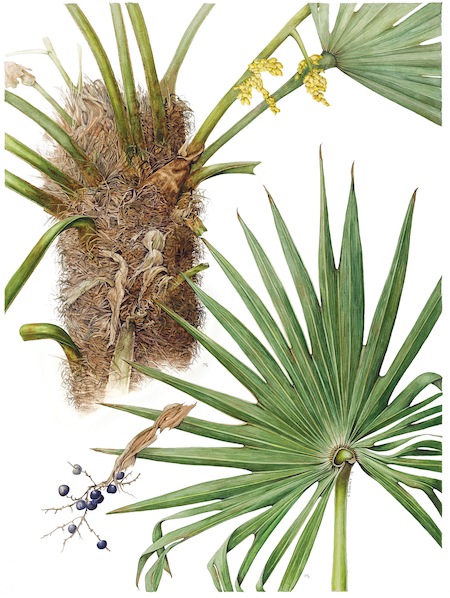
Trachycarpus fortunei (Chusan Palm), Shirley Slocock. Image © Royal Botanic Garden, Sydney.
‘To be a really successful botanical artist you need to have a very keen sense of observation – to see form and pattern in nature – you really have to get into a plant,’ said Morris.
The exhibition celebrates the importance of the Royal Botanic Gardens, which were central to the establishment of agriculture, commerce and horticulture in NSW. It reveals the lasting influence they had on the private gardens, public parks and landscapes of NSW since 1816.
‘Every plant has a story and there are different ways of looking at those stories,’ said Morris.
‘In Florilegium book we have arranged the plants by when they were introduced to the botanical gardens. In the exhibition we are talking about plants and their role and influence upon gardens in NSW and the way plants have been used in gardens.’
Viewers can trace the impact of the rainforest on early explorers and how those species entered our domestic gardens, to the cooler regions. The exhibition also references the importance of prominent gentlemen collectors such as Colonial Secretary Alexander Macleay and William Macarthur, who is noted for introducing the fragrant Magnolia grandiflora in the 1830s, now a fixture in Sydney gardens.
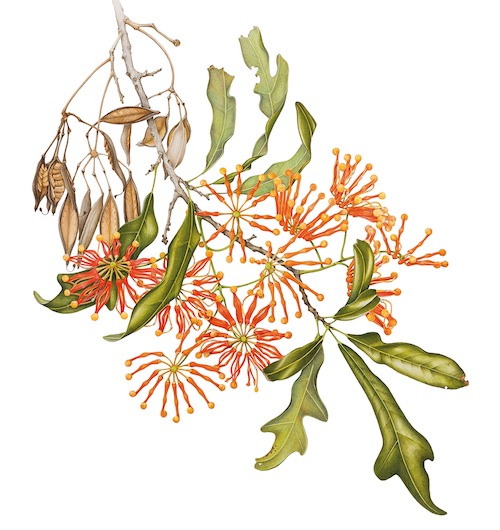
Stenocarpus sinuatus (Firewheel Tree), Angela Lober. Image © Royal Botanic Garden, Sydney.
Legacy, but not all lace
Once dismissed as an occupation for a spinster aunt, the image of floral art has been radically updated in recent years.
‘While our group is mainly women there have been some exceptional male botanical artists, especially in the field of scientific illustration’ said Morris.
There is an increasing interest in the changes occurring in the natural world, and the central role plants play in maintaining healthy ecosystems. Many artists and botanical illustrators are taking that next step by recording this passion for plants, and pushing the boundaries of what has been considered a traditional genre.
The exhibition of Lovegrove and Baüerlen provides a historical context, combining the talents of the lady flower painter Lovegrove and the insights of the botanist Baüerlen who brought species for her to paint.
Lovegrove and Baüerlen originally intended to publish their book The Wild Flowers of New South Wales in 25 parts. Only the first was finished, published by Angus & Robertson in 1891, with only a handful of copies known to still exist.
Morris said that while all history is interesting and the skill mind-blowing, the best part of this exhibition is the combination of the art with the garden experience. ‘You can look at all these painting with a kind of wonder and then go and walk in the Gardens and see the plants.’
Florilegium: Sydney’s Painted Garden is showing 30 July – 30 October, while The Artist & the Botanical Collector 13 August – 20 November. Check the website for curator talks and workshops.
The Museum of Sydney is located at corner of Phillip and Bridge Streets, Sydney.
